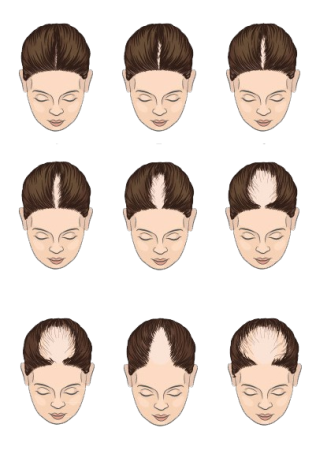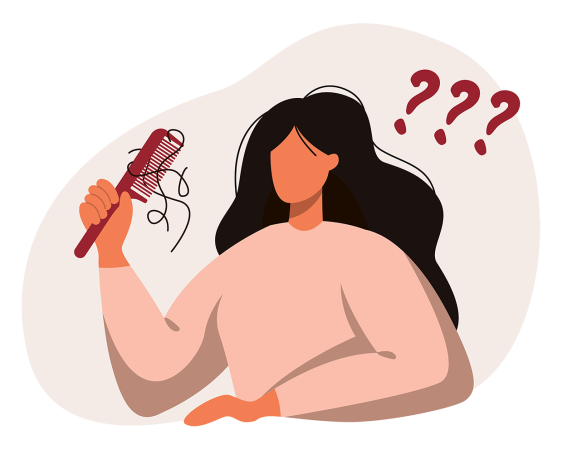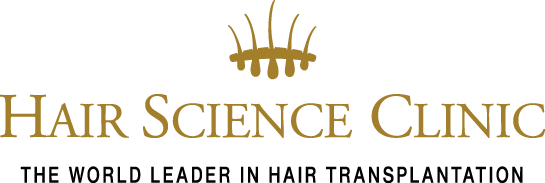Female hair loss
Baldness is mostly seen as a male problem, but it is definitely not. Forty per cent of all women suffer from hereditary baldness. Fifteen per cent of women even before menopause, sometimes at a young age.
In addition, many women suffer from (temporary) hair loss due to stress, iron deficiency or after pregnancy. Another two per cent of women have the condition alopecia areata, which causes bald patches.

causes of hair loss in women

Ludwig classification for hair loss in women
To treat thinning hair, it is important to find out the reason first. Usually, there is an identifiable cause for excessive hair loss. For instance, age plays a role, nutrition, stress, but illness, medication use or chemotherapy can also be causes. A proper diagnosis by a professional is always the first step in choosing treatment.
Most common causes
- hereditary baldness
- hair diseases
- hormones
- stress
- medication

Is it Hereditary hair loss or not?
Hereditary baldness (androgenetic alopecia) is the most common cause of baldness in women, as in men. This is not a hair disease, but a natural body process influenced by hereditary factors and hormones. In women, this type of baldness usually occurs at menopause when oestrogen production declines. The hair growth process becomes disrupted, resulting in thinning of the hair. Androgenetic alopecia is also known as ‘male pattern baldness’. Confusing, because it affects women too.
Signs of female hereditary baldness
In women, hereditary baldness can be recognised by even baldness spread over the hair surface. The hair becomes thinner from the crown all over the scalp. Eventually, this will lead to permanent baldness.
Other causes of hair loss
If hereditary baldness is not the cause, hair loss can have several other causes. In women, hormone fluctuations, such as during pregnancy and menopause, can be the cause of hair loss. Anaesthetic drugs, antibiotics, some anti-epileptics and malaria tablets are also known to sometimes cause hair loss. Cancer drugs (chemotherapy) are notorious for causing hair loss. Stress can lead to reduced hair growth or even a complete cessation of growth. Hair disease, such as alopecia areata, may also be present.
Worried about your hair loss?
Women are often shocked when they suddenly lose more hair than normal. Yet hair loss in women is no immediate cause for panic. It is often temporary in nature, and if the hair loss is already structural, it can often be dealt with. Examination by a medical specialist and getting the right diagnosis is always the first step to solve your problem.

Facts & figures
Impact of baldness
There is no part of the body that affects women’s self-esteem as much as their hair. Therefore, hair loss in women has a great impact on self-confidence. Baldness in women is not (yet) accepted. For example, a balding man can be a fine newsreader, a balding woman cannot.
Serious consequences
If, as a woman, you have to deal with hair loss, it is quite drastic. It can have major psychological consequences, such as insecurity about appearance, difficulties in establishing social contacts or even depression.
Hair loss - what is normal?
Hair growth occurs in three phases: a growth phase, a transition phase and a resting phase. At least 85% of our hair is in the growth phase. We lose the remaining 15% of hair in the following two phases.
Hair loss per day
Until the age of thirty, hair loss of up to fifty hairs per day is normal. Until the age of fifty, loss of up to eighty hairs per day is normal and after the age of fifty up to one hundred hairs per day. You don’t notice and see normal daily hair loss because it happens scattered over the head and not locally.
| <30 years: | 50 hairs per day hair loss |
| <50 years: | 80 hairs per day hair loss |
| >50 years: | 100 hairs per day hair loss |

Eyebrows
Reconstructing eyebrows naturally was not possible until recently. Hair Stem-cell Transplantation now offers that possibility, a definitive solution with beautiful, natural results. When reconstructing eyebrows, it is important to implant the hairs in the right shape and direction. Our doctors specialise in this.
Good to know
Often women notice that their hair is thinning, but no bald patches are visible. Hair loss is then seen – even by GPs – as a cosmetic problem. However, all research shows that baldness can cause major psychological problems and significantly affect quality of life.
For many forms of baldness, Hair Stem-cell Transplantation (HST) offers a solution, with a beautiful, natural result. Besides the proven cosmetic result, improving quality of life is an important consideration for people undergoing HST.


There is a solution
A proper diagnosis is important for determining the cause of your hair loss and choosing a treatment. During a no-obligation consultation with one of our doctors, we go into detail about your personal situation and wishes. Together with the doctor, you discuss your options and expectations. Based on this, you will receive an individual treatment plan.

